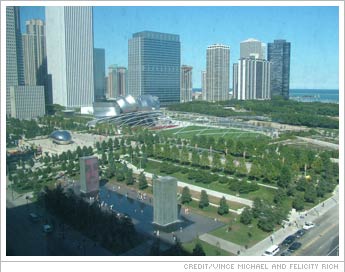By Vince Michael
When it opened two years ago, Millennium Park was four years behind schedule, hundreds of millions of public and private dollars over budget, and still not finished. It had all the makings of a disaster.
Within a week it was a smash hit and within two weeks city kids were putting on their swimsuits, getting on the “L” and heading downtown to splash in 1/8″ of water and the occasional spoutings of the Crown Fountain. The Bean, unfinished and still being polished in 2006, became an icon for the city in a fraction of the time it took for Picasso’s eponymous 1967 steelwork to do so. It was a triumph of ideas over reality and every Chicagoan and tourist loved it and still does.
Millennium Park fits its name because it is not real. It is a cheat and a fantasy – an artificial grass-covered roof over railroad yards that adheres to the letter of lakefront law in the cheekiest way imaginable. No buildings are allowed in Grant Park (which includes Millennium Park), thanks to a 100-year old lawsuit by Montgomery Ward, so grass and trees soar 40 feet above Michigan Avenue, tucking a 1,600-seat dance theater and a massive bandshell with backstage rooms beneath the surface. They built four-story buildings in Grant Park and then lifted the park up to cover the buildings.

They paid homage to the park’s original Plan of Chicago design by Edward Bennett, a formal garden filled with classical balustrades and terraces and pylons and even a huge curving peristyle of columns. The peristyle was lost when they built the Grant Park North Garage in 1959, but now it’s back, slightly scaled down, as the Wrigley Fountain. The balustrades came back too, but God knows what happened to poor old Alexander Hamilton, whose statue is still missing. It was an architectural park in 1917, very much about the city, and thanks to the Bean reflecting the skyline, it still is.
Look up from the classical Wrigley fountain to the Classical terraces of the promenade and on top of all this order preens the anarchic silvery concupiscent curds of Gehry’s decorated bandshell. The aesthetic disjuncture denies the classical clarity of the original park, but that is almost a virtue, because by denying symmetry and order it lets the visitor/viewer in. After all, the key to the success of the park is its interactivity. The Bean is a moebius mirror, that most elemental of interactive tools, while the Crown Fountain by Plensa smiles and spews with a different Everyman face every few minutes, inviting us to smile back, and perchance to spew.
Besides, even the Classicism in Millennium Park is as unreal as its hyper methamphetamodernism, just another stage set on what may turn out to be the longest running participatory public play in city history. Like a Vegas hooker, Millennium Park asks you what you want it to be: Your own fantasy and playground. It doesn’t need clarity or order or symmetry because it is a people magnet, and it is quickly transforming much of the downtown into sycophantic parasites sucking on its success.
By the middle of 2005, with the new park barely a year old, every old office building on historic Michigan Avenue was scrambling to convert itself into condos or apartments. Three old facades on Wabash sprouted the Heritage beanstalk, another fantasy looming over the Cultural Center like a glassine Godzilla, and next year an even larger – if more svelte – behemoth will scoop the guts out of three more old Wabash landmarks three blocks south. There is even talk of hanging balconies on 55 West Monroe, already one of the city’s most aesthetically challenged buildings. This park is a development magnet, turning the forlorn East Loop into the city’s hottest new neighborhood.
The most battered phrase in Chicago is “world city” but I can’t think of another word to describe the transformation here over the last 15 years. Millennium Park is a monument to that status; the checkered flag in Chicago’s race to become a boutique city like Milan or Vienna or Edinburgh or Nara or Heidelberg. It’s not just because a Spaniard designed the Crown Fountain (Chicago’s art and technology wizards made it work) and British South Asian designed the Bean, and a Californian added the foil and netting and snake bridge, in fact it has nothing to do with that kind of primer book diversity.
Twenty years ago I was on the first architectural boat tour on the Chicago River. The city was still big-shouldered then, but it was bleeding and kneeling while the referee counted to ten. On that boat we were trying to find ourselves a post-industrial city, to teach that boxer how to talk and think. When Millennium Park opened, the boxer was safely stuffed in the museum and the vaunted city of culture had arrived, pert, packaged and polished. Or almost polished.
See also Postcard Pablum: The Failure of Millennium Park, and Bean: A Love Story.
Posted on July 17, 2006


